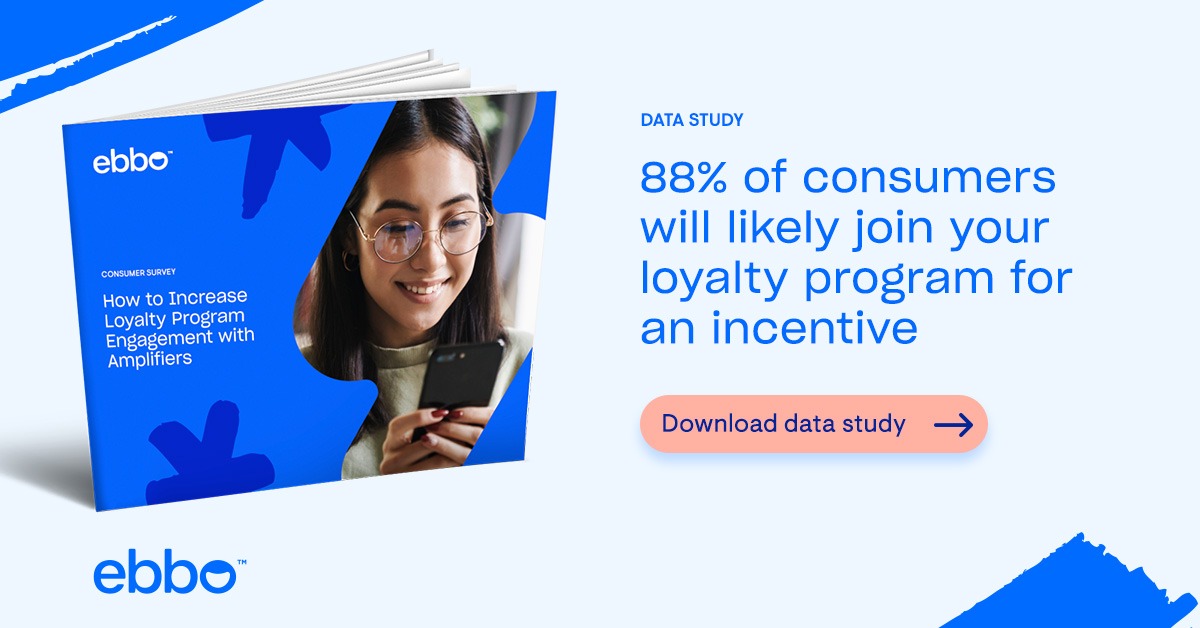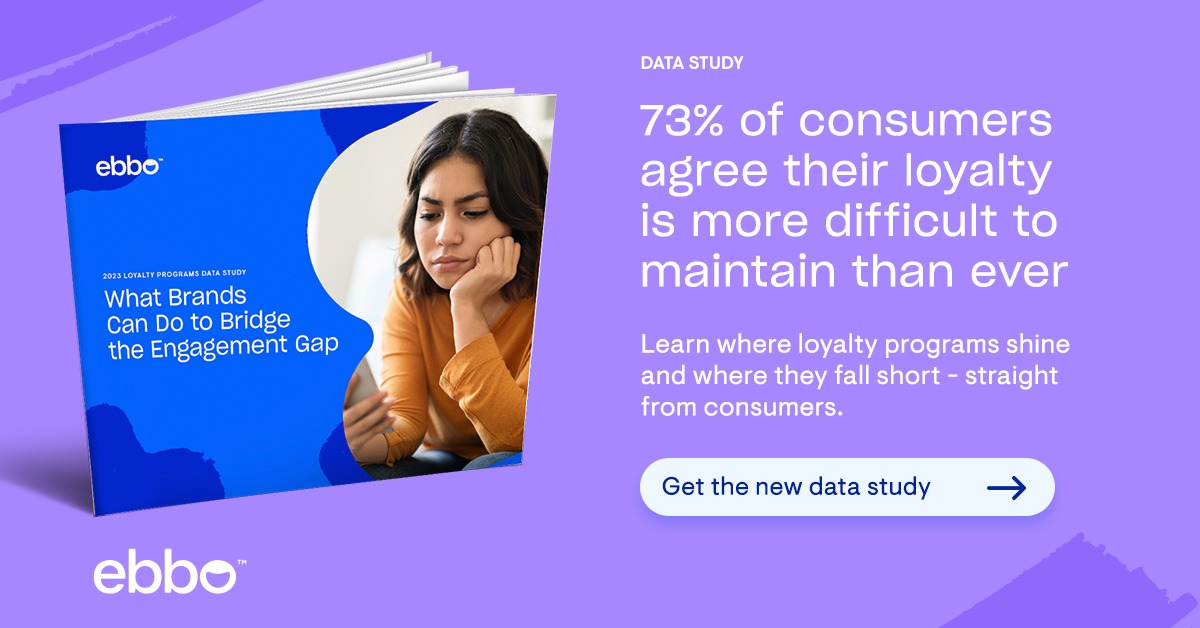Loyalty programs are more popular than ever, but there is a lot of opportunity and room for improvement for brands.
As you strategize about how to better engage your loyalty program members, here are 54 of the latest loyalty program statistics you need to know in 2023.
Table of Contents
- Loyalty Statistics Show How Important an Engaging Loyalty Program Is
- Where Loyalty Programs Can Improve?
- What Loyalty Program Benefits Do Consumers Want?
- How Do Consumers Feel About Tiered and Premium Loyalty?
Loyalty Statistics Show How Important an Engaging Loyalty Program Is
- 81% of consumers agree that holding a loyalty program membership to a brand influences their likelihood of making a purchase from that brand.
- 78% of consumers are likely to shop with a brand whose loyalty program they belong to versus one of their competitors even if the competitor is more convenient.
- Most (83%) of consumers belong to between one and six loyalty programs.
- 72% of consumers use 50% or less of their loyalty program memberships.
- 31% of consumers use only 25% of their loyalty program memberships.
- 73% of consumers agree that their loyalty is more difficult for a retailer to maintain than ever before, up from 68% in 2022.
These stats are impactful because they show the power and pull behind a loyalty program membership. Considering how consumers value convenience, these stats are even more amazing.
If your loyalty program benefits are exciting and appealing, your members will want to engage with your brand. These loyalty program statistics show that while a loyalty program can be very impactful when it comes to boosting customer engagement, there’s also a clear engagement gap.
Where Loyalty Programs Can Improve?
- 90% of consumers agree that in general, when it comes to being personalized to their preferences, most loyalty programs have room for improvement.
- 91% of consumers agree that many loyalty programs feel similar and are not that differentiated from others.
Top reasons consumers don’t sign up for loyalty programs:
- 42% said it requires too much effort/it’s time-consuming.
- 41% said the benefits/rewards aren’t interesting to them.
- 31% said I don’t like to share my personal information.
- 27% said it’s inconvenient.
- 23% said it feels bothersome or annoying when an in-store associate asks them at checkout.
- 22% said the brands I engage with most often don’t offer loyalty programs.
- 15% said I am generally unaware of brands’ loyalty programs.
- 9% said I don’t understand how signing up will benefit me.
Keeping your loyalty program fresh and exciting is a surefire way to retain members. And personalization is a big part of that two-way relationship.
Loyalty amplifiers are a great way to personalize the customer experience and collect valuable data. Incentives, like loyalty amplifiers (trivia, sweepstakes, and instant wins) enhance member engagement. In exchange for an incentive, 66% of consumers are likely to provide brands with more personal information and preferences to better personalize their loyalty program experience.
And the more data you can collect from loyalty program members, the easier it is to personalize customer experiences.

Download the 2023 Loyalty Amplifiers Data Study to learn more.
Regarding the top reasons consumers don’t sign up for brand loyalty programs, they all go back to what should be a key element of any loyalty program: Keep it simple for consumers.
Inconvenience is a big reason consumers don’t sign up for loyalty programs. But it’s in your power to make it convenient and simple. Make the loyalty program signup process simple or else consumers will simply look elsewhere. Train your frontline employees to educate customers about your loyalty program.
What Loyalty Program Benefits Do Consumers Want?
The most important rewards to consumers in a free loyalty program:
- 82% said discounts, coupons and/or cash-back on purchases.
- 57% said free or discounted shipping.
- 28% said surprise rewards.
- 26% said members-only experiences (i.e., early access to new product drops, members-only sales events, express checkout in-store, VIP customer service and community events).
- 20% said chances to win a prize.
Top 5 rewards that consumers most likely want to redeem points for:
- 80% said discounts on purchases (shopping, hotel and flights).
- 32% said branded merchandise/swag.
- 30% said sweepstakes entries for the chance to win a prize.
- 25% said gift points to friends or family.
- 21% said customizable digital rewards (make your own wine labels, branded photo frame to use on social media.)
Top 5 things consumers would love to see from their favorite loyalty programs in the future:
- 71% said more attainable rewards (not having to save up large amounts of points for big-ticket items but the opportunity to redeem smaller amounts of points for smaller rewards).
- 67% said more options for what you can redeem your points for aside from just coupons or discounts.
- 40% said being rewarded more for engaging with the brand beyond just purchase (like leaving a product review online, filling out a personality profile, taking a quiz or contributing user-generated content like sharing photos or an experience with the brand on social media).
- 25% said more access to exclusive members-only experiences.
- 12% said more of a sense of community for other brand fans (i.e., fan clubs, user groups, meetups and classes.)
Top 5 things consumers would love to see from brand loyalty programs to offer a great member experience:
- 64% said more attainable rewards (for example, being able to redeem smaller quantities of points for smaller rewards versus having to save up large quantities of points for bigger rewards).
- 47% said more personalization (more of the features, benefits and/or products that you are most interested in versus being shown the same content that everyone else sees).
- 40% said more options on how to spend points (i.e., the ability to donate points to charities or share points with friends and family versus only being able to redeem points for discounts or products).
- 35% said better communication (the right amount of communication at the right time from the brand in your preferred channel(s) like email versus SMS.)
- 34% said multiple tiers that better align with their shopping habits (i.e., tiers that offer different rewards based on your yearly spending with the brand, or a premium tier that offers the best benefits in exchange for a membership fee like Amazon Prime).
Many points-based loyalty programs reward members with discounts after they reach a certain points threshold. While discounts remain the most popular reward for loyalty points, there are other options to consider like branded swag or gift points to friends/family.
Read about how brands can increase customer engagement by offering unique loyalty program rewards.
Consumers want choices and this doesn’t mean you should stop offering bigger ticket rewards.

Download the 2023 Loyalty Programs Data Study.
But if you offer things like a chance to win a prize, a customized digital product or a donation to a charity – all things that don’t require a lot of points – your loyalty program members will engage more often.
The more attainable rewards you offer members, the more they’ll engage. Loyalty amplifiers like instant wins and sweepstakes are great engagement tools to use because they generate excitement and anticipation.
Read how instant wins elevate loyalty program engagement.
Younger shoppers (21%) also want exclusive, in-store experiences while older shoppers (7%) don’t care as much about them.
It’s important to design your benefits based on your audience and these companion stats show how you should strive to offer a mix of transactional and experiential benefits for your loyalty program members.
Transactional benefits draw your customers in while experiential benefits help retain them. And transactional benefits impact your customers instantly while experiential ones leave lasting impressions that build emotional connections and create brand advocacy.
Learn more about transactional and experiential loyalty program benefits working together.
How Do Consumers Feel About Tiered and Premium Loyalty?
- 74% of consumers agree that they would engage more with brands that offered different tiers in their loyalty programs based on how much they spend per year.
- More than half (56%) of consumers plan to join additional premium loyalty programs in the next 12 months.
- 74% of consumers are likely to invest in a retailer’s premium loyalty program if they already belong to that retailer’s traditional loyalty program.
Perks that would motivate consumers to invest in or renew a premium loyalty program:
- 57% said free shipping.
- 52% said instant discounts that can be used whenever you shop (e.g., 20% off every purchase without the need for a coupon or accruing points).
- 49% said free giveaways.
- 39% said faster shipping.
- 33% said surprise rewards.
- 32% said exclusive deals (e.g., access to pre-sales).
- 28% said holiday discounts.
- 27% said personalized offers.
- 17% said exclusive in-store experiences (e.g., a personal stylist, fitness classes or a VIP fast lane at checkout).
- 11% said nothing would motivate them to invest in a premium loyalty program.
Why consumers don’t currently belong to any premium loyalty programs:
- 37% said they’re too expensive.
- 25% said I don’t see the value.
- 26% said I’m open to them, but the retailers I shop with don’t offer them.
- 77% of consumers would still want to remain a member of a brand’s free loyalty program if they’re thinking of canceling their premium loyalty membership because they’re not getting enough value out of it.
This group of loyalty program statistics tells you that consumers want options.
Tiers add appeal to your loyalty program because certain benefits can be tied to how much members spend and they can choose what tier they want to join.
You can also include a premium loyalty tier, which is a subscription-based loyalty program that can be added to a tiered points-based program. Consumers pay a membership fee to join a premium loyalty program to receive exclusive benefits.
Premium loyalty programs’ popularity continues to rise. It’s been a steady progression since 58% of consumers belonged to a premium loyalty program in 2019, 66% in 2020, 70% in 2021, 72% in 2022 and 77% this year.
When you offer loyalty program tiers, you give your customers and there is more excitement around that for your program.
Read how a premium loyalty tier can complement your free loyalty program.
It all ties back to the theme of offering tiers in your loyalty program to broaden your potential reach.
Premium loyalty can provide you with a separate and impactful revenue stream to augment your business. If your value proposition and rewards are enticing and valuable to consumers, they will engage with you.
Read our Premium Loyalty 101 Guide.
When you combine a loyalty program with a premium tier, you’re giving customers options and the freedom to move within your loyalty ecosystem. If a customer cancels a premium loyalty membership, the brand does not lose them entirely because they’re still in its loyalty ecosystem.
For those numbers to jump nearly 20 percentage points in four years is impressive, especially when more than a quarter (26%) of brands don’t offer premium loyalty programs.
Read more about why premium loyalty adoption is rising and consumer expectations are shifting.
New Loyalty Program Stats Paint a Clear Picture
Loyalty membership is on the rise, but as you can see from these new customer loyalty stats, there are a lot of opportunities to make the experience better for your members.
Try and make your loyalty program easy for consumers to join and engage with, add personalization with more attainable rewards and consider incentives to elevate engagement.
Consumers are saying what they want from a loyalty program, so if you address their expectations, you’ll create stronger two-way relationships.